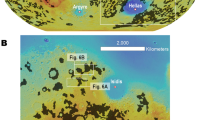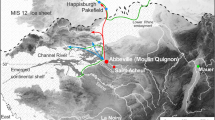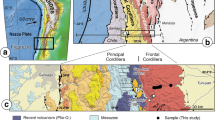Abstract
Contrasts of Facies of Contemporaneous Formations in the Alps GEOLOGICAL formations may vary greatly in character, or facies, from place to place. In the Swiss Alps the Mesozoic sediments show several facies associations, sufficiently definite to be given names. Of these the most commonly encountered is called Helvetian, while another of more restricted occurrence is called the Klippe facies. The name Klippe is taken from the German word for a cliff, because this particular facies is well displayed in some cliff-bounded mountains which form a conspicuous scenic element in the neighbourhood of Lake Lucerne. Equivalent formations exhibiting the Helvetian and Klippe facies are often so completely different in appearance that no one would guess their contemporaneity were it not for their contained fossils. This is truly amazing because the two facies in many localities lie cheek by jowl.
This is a preview of subscription content, access via your institution
Access options
Subscribe to this journal
Receive 51 print issues and online access
$199.00 per year
only $3.90 per issue
Buy this article
- Purchase on Springer Link
- Instant access to full article PDF
Prices may be subject to local taxes which are calculated during checkout
Similar content being viewed by others
References
Schardt, H., C.R. Acad. Sci., Paris, 117, 707 (1893): Arch. Sci. Phys. et Nat., Genève, 3rd ser., 30, 570 (1893).
Griesbach, C. L., Rec. Geol. Surv. India, 26, 19 (1893).
Krafft, A. von, Mem. Geol. Surv. India, 32, 127 (1902).
Diener, C., Mem. Geol. Surv. India, 36, 132 (1912).
Griesbach, C. L., Rec. Geol. Surv. India, 26, 25, which carries an editorial note that "Mr. Middlemiss does not accept this explanation" (1893).
Griesbach, C. L., Compte Rendu IX Sess. Con. Géol. Internal. (Vienna, 1903), 2, 550 (1904).
Diener, C., Mem. Geol. Surv. India, 28, 21 (1898).
Diener, C., Mem. Geol. Surv. India, 36, 139, 140 (1912).
Suess, E., C.R. Acad. Sci., Paris, 139, 714 (1904).
Bailey, E. B., Bull. Geol. Soc. Amer., 47, 1722 (1936).
Heim, Arnold, and Gansser, A., Mém. Soc. Helvétique Sci. Nat., 73, 174, 184 (1939).
Griesbach, C. L., Mem. Geol. Surv. India, 23, 83, 84, 130, 155 (1891).
Lydekker, R., Mem. Geol. Surv. India, 22, 111 (1883).
Wadia, D. N., Rec. Geol. Surv. India, 68, 419 (1935).
Lydekker, R., Mem. Geol. Surv. India, 22, 116 (1883).
Bailey, E. B., Geol. Mag., 81, 99 (1944).
Bailey, E. B., "Tertiary and Post-Tertiary Geology of Mull, Loch Aline and Oban", Mem. Geol. Surv., 120 (1924).
Reid, C., and Dewey, H., Quart. J. Geol. Soc., 64, 267 (1908).
Suess, E., "La face de la terre", 3, 1497–1505 (de Margerie Ed., Paris, 1918).
Hollingworth, S. E., Taylor, J. H., and Kellaway, G. A., Quart. J. Geol. Soc., 100, 1 (1944).
Author information
Authors and Affiliations
Rights and permissions
About this article
Cite this article
BAILEY, E. Mountains that have Travelled Over Volcanoes*. Nature 154, 752–756 (1944). https://doi.org/10.1038/154752a0
Issue Date:
DOI: https://doi.org/10.1038/154752a0
Comments
By submitting a comment you agree to abide by our Terms and Community Guidelines. If you find something abusive or that does not comply with our terms or guidelines please flag it as inappropriate.



